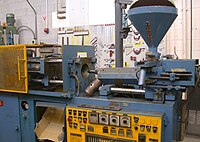
Photo from wikipedia
Mechanical properties determine the use of two-component polyurethane materials. The compatibility of two components in the polyether polyol-MDI molecular system greatly influences the formation of mechanical properties in polyurethane materials.… Click to show full abstract
Mechanical properties determine the use of two-component polyurethane materials. The compatibility of two components in the polyether polyol-MDI molecular system greatly influences the formation of mechanical properties in polyurethane materials. In this paper, we studied and evaluated the compatibility and mechanical properties of two-component polyurethane at multiple scales by combining molecular dynamics simulation with macroscopic experiments, which is an important guideline for synthesizing and preparing two-component polyurethanes. We evaluated the stability of the two-component polyurethane system by calculating the solubility parameter, binding energy, and diffusion coefficient at four temperatures with three isocyanate contents. The Perl scripting language obtained the mechanical properties of the MDI-polyether polyol system. The MD calculation results show that the solubility parameter of two-component polyurethane negatively correlated with temperature, and the intermolecular binding energy and MDI diffusion coefficient positively correlated with temperature. When the mass ratio of polyether polyol to isocyanate was 1:0.6, the solubility parameter difference between the two was 1.43 (J/cm3)1/2, the intermolecular binding energy was 531.68 kcal/mol, and the two-component system was more stable. A macroscopic direct tensile test was employed to assess the polyurethane elastomers’ tensile properties. Our results show that the tensile strength of polyurethane elastomers increased with the increase in isocyanate content and decrease in temperature. Furthermore, the elongation at the break decreased, and the modulus increased, which is consistent with the law of molecular simulation.
Journal Title: Materials
Year Published: 2023
Link to full text (if available)
Share on Social Media: Sign Up to like & get
recommendations!